
Flight 587 Crash Case Covers Wide Range of Key Safety Issues
The investigation into the fatal crash of an American Airlines [AMR] twinjet may illustrate that the vaunted ethic of industry partnership on safety issues can be severely eroded, shifting from comity to confrontation, when the liability monster raises its head.
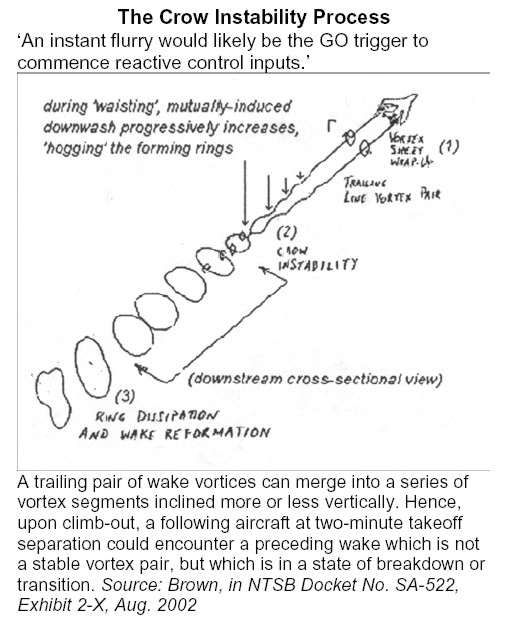 |
The case is amply illustrated by the ongoing investigation into the fatal Nov. 12, 2001, crash of American Flight 587, which involved an Airbus A300-600 twinjet. The composite tailfin separated from the Airbus jet, causing it to plunge into the Belle Harbor residential area in New York City, killing all 260 aboard and five persons on the ground The accident marked the second time in recent years where structural failure was involved in loss of control. On Jan. 30, 2000, an Alaska Airlines [ALK] MD-83 twinjet was lost with all 88 souls on board off the cost of Los Angles, Calif., when the horizontal stabilizer separated from the aircraft.
National Transportation Safety Board (NTSB) investigations into both crashes are proceeding. Of the two, the Alaska crash may be simpler, as the remedy to the failed jackscrew that caused the stabilizer to break off the airplane's T-tail is at hand in the shape of a failsafe design developed by engineers at the Kennedy Space Center (see ASW, Nov. 18, p. 1).
The A300 crash is considerably more complex, involving issues of pilot-machine interaction, wake turbulence, rudder system and composite structure design and certification, and possibly even modified air traffic control procedures. The range of issues and their significance could have a profound impact.
The two cases do have one aspect in common: in both cases, immediate actions were taken in response to malfunctioning flight control systems. On the Alaska jet, the pilots reset the circuit breakers controlling the jackscrew motors moving the horizontal stabilizer perhaps as many as eight or nine times, according to documents released as part of the investigation. Each time the breakers were reset, the re-energized motors stripped more thread off the acme nut connecting the stabilizer to the tailfin. On the American jet, a malfunctioning yaw damper was reset before takeoff. Some sources believe both cases may reveal symptoms of system failures which, particularly in the latter case, may not yet be fully appreciated.
During the NTSB's recent hearings into the A300 crash, Airbus officials denigrated American's upset recovery training program for the emphasis it placed on rudder use (which American representatives vigorously denied was misplaced). For their part, American officials countered that the airplane and its A310 cousin had a history of inadvertent high tail loadings, and that Airbus had not advised of any restrictions on rudder use below maneuvering speed - at least not until months after the accident.
The four days of hearings evidenced more of the high drama of a courtroom proceeding than a dry, dispassionate discussion of technical issues (see ASW, Nov. 4, p. 1, & Nov. 11, p. 1).
To summarize:
- It was not proven that the pilots, and First Officer Sten Molin, the pilot flying, moved their rudder pedals. Despite circumstantial evidence pointing in this direction, the DFDR sampling rate and necessary interpolation would seem to make any such finding inconclusive.
- On the other hand, it has been demonstrated that the rudder load limiter did not restrict the rudder to limit load or below ultimate load (fail-country). Furthermore, it has been demonstrated that two other incidents have occurred where the autopilot did not declutch from the rudder channel and design loading was exceeded on the tail. In both of those cases, the rudder pedals moved on their own for the duration of the event, sources say.
- From what has been gathered thus far, the regulated design standards affecting all manufacturers may not provide sufficient margins for what is believed by some were the actions of the accident crew. It is now deemed unsafe to apply the rudder first one way and then the other, because the first application yaws the plane such that aerodynamic forces on the fin and rudder will be that much higher when the rudder is reversed.
- Other incidents that may bear on the Flight 587 case are yet to be addressed, such as the Nov. 25, 2001, airspeed fluctuations on a Singapore Airlines A340 during uncommanded yawing (i.e., overspeed warnings and large rudder movements without pilot input, according to initial reports).
- The Airbus checklist for dealing with an unlocked landing gear, since changed, called for alternating rudder-pedal inputs to induce back-and-forth sideslips to lock the gear in place. Some sources assert that this procedure involved doublets (full opposite deflection of rudder without stopping at the neutral position). Use of opposite rudder is now restricted to engine-out and crosswind landing scenarios.
- Following a 1997 incident in which ultimate load was exceeded on the tailfin of another American A300, the airline and manufacturer Airbus were at odds with each other over the sharing of digital flight data recorder (DFDR) information, which the manufacturer deemed vital to understanding the event and which the airline apprehended could be used as grist in legal proceedings against it. The notion of partnership in problem solving and of "data-driven" safety was significantly challenged.
- With the Flight 587 crash, and all the uncertainty and controversy surrounding it, the case has never been stronger for more capable DFDRs, quick access recorders (QARs), cockpit voice recorders (CVRs) and for closed circuit television cameras (CCTV). One might argue that over the life of any airplane, the ability to accurately dissect accident outcomes should be as important as certifying its airworthiness. One of the great limitations in the Flight 587 case is the absence of data on forces applied to the sensitive rudder pedals. Movement was recorded, not force. The pilots unions have an incentive to get on the bandwagon for improved recorders, as they can see now that one of their number, unfortunate to qualify as an accident pilot, is being subjected to postmortem allegations of incompetent malfeasance.
It may be useful to probe deeper into various aspects of the case.
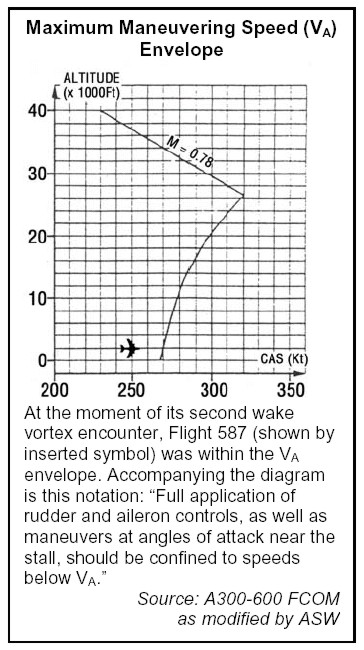 |
Pilot actions and the reconstruction video
The video produced by the NTSB shows pictures of the plane and the attitude indicator, along with graphic displays of the positions of the rudder pedals and the rudder. The re-creation was all derived from filtered DFDR data and the CVR.
As the plane taxis, one can see the yaw damper/auto-coordination system functioning. As the aircraft exits the taxiway and turns onto the runway, the rudder deflects left without the rudder pedal moving, i.e., the "system" thinks the aircraft is yawing nose right and makes corrective action. When the aircraft stops on the runway, the rudder deflects right, which then slowly decays to zero (centered), again without the rudder pedals moving.
These indicators suggest that the rudder control system was functioning properly.
During the first wake encounter with the Japan Air Lines (JAL) B747-400 that preceded Flight 587, the rudder moves slightly on the DFDR tracings, but the rudder pedals hardly move - suggesting that feet were on the pedals but they were used with great restraint.
The second wake encounter is extremely short - about 10 seconds from start to tailfin separation - and extreme coordinated yoke and rudder pedal movements are shown almost from the start. In a freeze-frame of the second wake vortex encounter, the pedal limiter was overpowered but the rudder limiter was not (see box ANIMATION). Throughout the final fatal sequence the rudder does not move outside of its system limit of 10º deflection (at that speed, 250 knots) left or right. A cautionary note: the DFDR is not capturing virtual reality - it was sampling rudder movement at a rate of twice per second. Given the rudder's ability to move at 39º per second, it could move (undetected by the DFDR) left or right nearly to its full limit and back to the centered position within the sampling interval.
The rudder pedal positions were being sampled at twice per second, also. Some pilots who originally thought it was impossible to impart four rudder reversals inside seven seconds now concede that they had no idea that pedal movement of just 1.3 inches would command a full 10º deflection. They now say that just pressing with toes conceivably could move the pedals that rapidly.
Airbus officials testified during the hearings that if the pilot applies 130-140 pounds of pressure on the pedals, the variable rudder stop could be stalled, and the mechanical "elasticity" of the rudder control system might actually result in the rudder moving beyond its programmed limit. However, in the event of such a limiter stall, a warning chime will sound in the cockpit. No such warning was captured on the CVR. So, apparently, the pilots did not stall the variable stop. Additionally, there is no valid (i.e., unfiltered) evidence that the rudder panel moved outside limits. The evidence in this regard may be a point of even greater concern, because it suggests that a failure may be caused below maneuvering speed by a to-and-fro cycling of the rudder panel without it going out of limits.
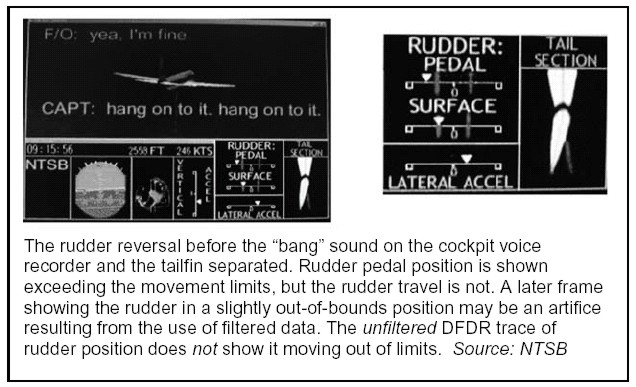 |
In any event, the readout shows four full opposite yaw damper oscillations and five full-travel opposing pedal movements in the last seven seconds that the tail was attached. The yaw damper shows a classic sine wave with a lengthening period over the seven-second interval, while the pedal movement shows greater excursions both in and out of phase with the yaw damper. During one two-second period the rudder pedal was in the fully right position. The scenario that comes to mind might be described as a "man-in-the-loop system induced oscillation" (SIO).
Rudder control system design
Given the minimal movement needed on the pedals, if Capt. Ed States was resting his feet on the pedals, he may have had no cause for alarm, not realizing that each perceived slight movement of the pedal, unlike the four inches of available pedal movement on the ground, was fully deflecting the rudder. He voiced no concern on the CVR about Molin's control inputs. States may have been anticipating emerging momentarily from the condition and saw no reason for undue concern or correction. After all, wake turbulence encounters are not rare.
Indeed, by unconscious comparison with the four inches of pedal movement felt during the rudder performance check conducted just before takeoff, the pedal movements during the second vortex encounter might have impressed States as being rather restrained.
Airbus officials believe the light forces on the pedal enable pilots to more accurately control the airplane. Some pilots agree. However, since AA587, the A300 simulator's characteristics have been drastically altered to more truly reflect the airplane's characteristics - so some pilots may be in for a surprise come their next simulator session. This is a fact (i.e. the sim has been modified)
Others assert that the forces, 22 pounds to overcome friction plus another 10 pounds to move the pedals, are so light that it could be difficult to modulate control of the rudder. This school of thought holds that the pilot may well lose any feel for the center position fairly quickly, and that going from full left to full right is easier in feel than going from neutral.
One pilot suggested an automobile analogy, in which the brakes become more sensitive with an increase in speed: "Picture a car going 80 miles per hour and the only thing that will happen if you touch the brakes is that the wheels lock."
This comparison may not be entirely apt. On the A300, with an increase in speed both the allowable pedal input and rudder output are increasingly restricted.
Rudder system certification standards
As a consequence of the Flight 587 accident, certification standards are under scrutiny. The regulations as published by the Federal Aviation Administration (FAA) outline only a maximum rudder pedal force of 150 pounds, but no minimum. Also, there is no standard ratio of breakout force to the force required to achieve maximum displacement of the rudder pedals. Is 10 pounds from a 22-lb. breakout to a 32-lb. maximum at 250 knots appropriate? What about the relatively small distances the pedals move at higher speeds? On some other aircraft, the pedal movement at 250 knots is even less than that for the A300.
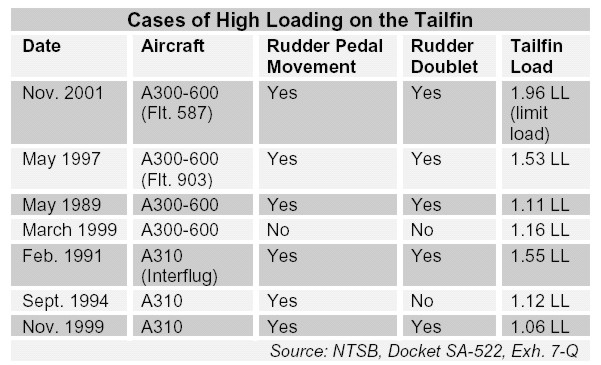 |
Nor do the regulations address the structural strength needed for rapid back-and-forth deflection of the rudder. Erhard Winkler, an Airbus senior composites engineer, said at the outset of his prepared presentation to the NTSB, "The most important thing for an aircraft structure is that it should be strong enough to resist all load conditions as required by FAR 25 [Federal Aviation Regulations, Part 25, which applies to airliners]." Winkler did not say "strong enough to withstand all possible loads." Yet there are seven cases where limit loads were exceeded on the A300 and its A310 cousin. In five of those cases rudder doublets were involved. Three of those events (including Flight 587) went beyond ultimate load, and doublets were recorded in each of those events (see box LOADS).
In six of the seven cases where limit load was exceeded, rudder pedal movement was recorded, and doublets were recorded in five of those six cases. This itemization presented by Airbus during the hearings suggests that pilot are making inappropriate use of the rudder. Capt. Bob Tamburini, an A300-600 pilot, sharply disputes any such intimation. "Why are there so many A310/A300-600 aircraft that have experienced incidents of significant loading?" he asked in a recent communication to this publication. "Do pilots, once they qualify in these aircraft, immediately take stupid pills?"
More broadly, the absence of any consideration in the regulations for rudder doublets is striking in light of what has been known and for how long. Consider the conclusion from this 1946 National Advisory Committee for Aeronautics report of dynamic loads on the vertical tail:
"An oscillating rudder deflection of small amplitude causes large loads that are reached in a short time. The rudder motion necessary to maximize the load is very moderate because of the low natural frequency of the airplane. One cycle executed in 8 seconds is sufficient to raise the load on the vertical tail surfaces to 2400 pounds per degree. An amplitude of only about 9º would therefore be necessary to cause failure of the tail with this type of deflection. The initial cycle of a fishtail maneuver may be considered as a rudder reversal and its critical nature is shown by the fact that 86 percent of the load corresponding to final resonance is attained with only 1 cycle of rudder motion."
"The importance of this type of control-surface deflection is recognized for the horizontal-tail load, and present requirements specify a standard elevator deflection ... for computing critical loads. A need is seen ... for the vertical tail ... of what is required ... in regard to yawing maneuverability."
One question posed at the hearing but not directed to any particular individual was "How can we continue to certify an aircraft that can be broken by use of its certified flight controls?" The answer given was along the lines that it has always been the case that aircraft can be broken by the use of pitch controls, and pilots have been expected to stay within the pitch envelope. So, too, are pilots now advised to stay within the yaw envelope.
Maneuvering speed limits
Critics charge that the word has been slow in coming out on a subject of such fundamental importance as the maneuvering envelope of the airplane. It has been traditionally understood that full use of the flight controls can be made within that envelope. Indeed, the accident aircraft was within the bounds of the maneuvering envelope when the numerous roll and yaw movements were recorded (see box VA). Interviewed after the accident by the NTSB, Capt. Paul Railsback, American's managing director of flight operations, was specifically asked about his understanding of maneuvering speed and if it provided protection against sequential and opposite deflections of the rudder. "I would expect it to," he replied (see ASW, Nov. 11, p. 10).
A recently retired B777 captain from another airline demurred, saying, "I've never thought the definition of maneuver speed was meant to include rapid inputs including rapid reversals."
"It's true that if you lose the right engine at V1 (say, 145 knots) you will not hurt the airplane if you whap the rudder full left to maintain directional control. But it is not true if VA is 270 knots that you can whap the rudder full left, full right, full left, etc., without causing something to break. That was never the intended definition of VA," he argued.
Indeed, in a March 2002 flight crew operating manual (FCOM) bulletin to A300/A310 operators, Airbus cautioned against the notion of unrestricted use of flight controls at speeds within the VA envelope:
"Sudden commanded full, or nearly full, opposite rudder movement against a sideslip can ... result in structural failure. This is true even at speeds below the maximum design maneuvering speed, VA."
If this interpretation is now the received wisdom in the industry, it represents more than a technical clarification and affects operating procedures. Consider the 270-knot speed mentioned by the pilot above. That is coincidentally the maximum speed at which the landing gear can be extended on the A300-600. If the crew receives a warning chime that the gear is lot down and locked, note the difference in FCOM procedures before and after the Flight 587 accident:
Before: "If one gear remains unlocked, accelerate to Vmax ... and perform alternating side slips in an attempt to lock the gear." (FCOM, Rev.25)
After: "Sideslip should be initiated using the rudder on the same side of the aircraft as the unsafe gear indication, i.e., if the right main landing gear is unlocked, slowly apply right rudder up to full deflection if necessary while maintaining wings level to generate sideslip. If the gear still fails to lock, then slowly return the rudder to neutral ... and then slowly apply opposite rudder. If necessary, repeat this cycle in an attempt to lock the gear." (FCOM, Rev. 26)
It should be noted that American eschewed this procedure, enjoining its pilots to bank the aircraft to one side than the other in an attempt to lock the gear. The carrier that has been charged with advocating excessive rudder use in upset recovery did not advocate rudder use as an expedient action drill to resolve an unlocked landing gear warning.
In any event, the whole issue of VA may trace back to that 1946 NACA paper, and its concern about how easily rudder reversals can induce ultimate load and its urging that strength requirements for the tailfin need to be more clearly specified. During the course of the NTSB hearings, reference was made to a "Russian-type" maneuver. Apparently, the Russians require sufficient strength to withstand a rudder doublet as part of their certification standards. The NACA paper brought up this critical point some 56 years ago.
Data sharing
In an industry where the sharing of data is seen as key to advancing safety, documents released as part of the Flight 587 crash reveal the opposite. American officials groused that the manufacturer had not apprised them of previous incidents where the A300/A310 experienced extreme loadings. Among them, the successive stalls of an Interflug A310 in February 1991 in which the tailfin experienced 1.55 limit load. Nor, said American officials, had they been advised of the 1.53 limit load experienced by their Flight 903 during a May 12, 1997, stall event involving an A300.
"This information was never handed to the NTSB or to the parties [to the investigation]," groused Tim Ahern, American's vice president of safety, during the hearings. Airbus' John Lauber countered that American was advised by e-mail at 6:13 p.m. on June 19, 1997, that the incident airplane had likely experienced ultimate load and needed to be inspected "as early as possible." A follow-up e-mail was sent just two hours later, "We kindly ask you to send to Airbus Industrie urgently the details of the inspections ... top priority should be given on the rear part of the aircraft."
"The event was 12 May, why the delay?" Lauber asked Michel Curbillon, the Airbus witness at this point in the hearings.
"We needed more DFDR information," Curbillon replied.
Lauber then charged that three days after the May 12 upset the carrier had refused to release the requested DFDR information. The exchange of messages over release of the DFDR data reflect a high degree of frustration between the two parties (see box F).
NTSB member George Black said unhappily, "I am concerned about the flow of information in the [Flight] 903 case."
The tailfin remained in service on the incident aircraft for five years, until it was removed after the Flight 587 crash for non-destructive examination (NDE). Additional calculations further confirmed that the fin had experienced more than ultimate load in the 1997 event and it was not returned to service.
|
|
||
Composite materials
The Airbus philosophy with respect to composite materials received a big boost from an independent expert during the hearings. Airbus engineers have argued, in the face of considerable criticism, that damage to composite materials not detected visually is not sufficient to compromise structural strength, and that even hidden damage below established thresholds will not grow or worsen in service (see ASW, July 29, p. 3). Dr. Jim Starnes, a senior composites expert at the National Aeronautics and Space Administration (NASA) testified that after his detailed examination of the engineering data, he agrees with the "no growth approach for flaws below a critical size." "At this point, I don't think we have a materials degradation issue over time," he said.
Starnes' statements are not likely to end the controversy. On the basis of a 1997 airworthiness directive (AD 97-04-07) the first 80 rudders on the
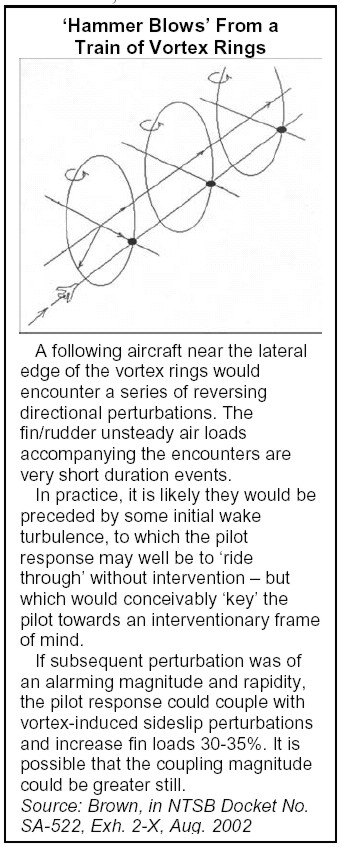 |
A310/A300-600 fleets were replaced due to disbonding. On March 22, the FAA issued AD 2002-06-09 mandating inspections of the tailfins of any A310/1300-600 aircraft that encounter lateral loads of 0.3G or more. Tamburini and other A300-600 pilots who have banded together to voice their concerns to the FAA believe these ADs point to potentially unresolved aspects of composite durability with respect to delamination, cross-ply cracking, and moisture/freeze damage.
Wake vortex encounters
Flight 587 was in a climbing turn at the time of the accident, and it encountered the second wake vortex from the preceding JAL jet at a more acute angle than its passage through the first. As a consequence, the airplane was traveling right amidst the wake vortex turbulence for a significantly longer time. NASA meteorologist Fred Proctor described wake vortices in general as "mini weak tornadoes."
Strongest when they spill off the wingtips, the vortices were about 60-80 percent of their original energy when Flight 587 encountered them. The different computer models used to estimate them explain the variance, Proctor explained. Also, by then, the vortex energy was oriented differently in relation to the flight path of the following airplane.
A unique combination of circumstances may have played out its deadly implications in the Flight 587 accident, according to an August 2002 engineering study. Anthony Brown, an engineer-pilot at the Flight Research Laboratory of the Institute of Aerospace Research, an arm of the National Research Council (NRC) of Canada, evaluated the potential for adverse airplane-pilot coupling along a flight path through a series of vertical-axis vortices. His scenario could have implications for wake vortex encounters because situations exist where the pair of trailing vortices mutually attract each other together, "waisting" at periodic downstream spacing. Brown explained that as they move together, each vortex induces the other downwards. Eventually, the pair link together to become a series of "arched over" individual vortex rings, which then break down (the image of smoke rings comes to mind). Known as "Crow instability" (named after its discoverer), the process can last from 30 seconds to a minute. (see box CROW).
A following airplane flying through rather than across these rings could experience a series of sharply defined directional load pulses (see box HAMMER). If each pulse meant a yaw axis swerve, the sensation might have stimulated Molin into trying to correct with rudder pedals.
Brown estimated in his paper that flying through a series of vertical vortex elements would produce sideslip angles of up to 10º along with "extremely dynamic reversals" (the analogy of hammer blows comes to mind).
The pilot's immediate corrective responses could be exactly out-of-phase, leading to forces on the tailfin of 1.3 to 1.6 of limit load. Using a simplified reactive pilot model to study the potential interaction, Brown wrote, "There is observed to be significant coupling between pilot-actuated rudder deflections and induced sideslip ... upon approaching and penetrating each vortex core," In fact, he went on to say, twice limit load could be reached in short order with this "rudder/vortex" coupling effect - very close to the 1.96 limit load at which the tail broke off Flight 587.
Brown referred to the Flight 587 accident scenario in his study. The accident airplane experienced lateral forces of 0.3 G, about which Brown wrote: "Noting that resting frictional force is generally about 0.3G, any lateral acceleration or acceleration reversal above this value would ... accelerate any and all objects. Suddenly seeing and/or hearing any object move sideways across the cockpit with an instant flurry would likely be the 'GO' trigger to commence reactive control inputs, a commencement which would be unlikely to involve conscious decision-making. Indicators of a lack of conscious decision-making would be the control input rates and a lack of any remark from the pilot regarding intended actions."
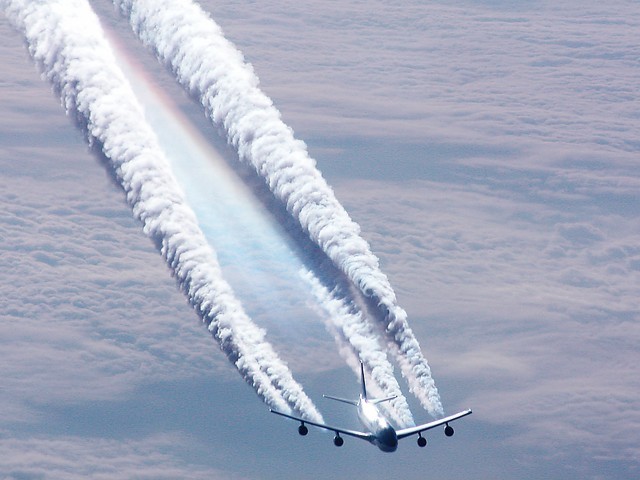 |
This is precisely what the DFDR and CVR data show in the Flight 587 case - rapid rudder pedal movement and nothing more remarkable in the way of verbal utterances than Capt. States' query, "You all right?" followed by, "Hang onto it" about two seconds before the tailfin broke away.
Again, recall that early NACA paper - 86 percent of limit load in one rudder reversal - and it may all come together: Crow instability + transiting along the wake + a powerful rudder system + a light touch on the rudder pedals + the pilot's reactive control inputs = structural failure.
In a telephone interview, Brown said, "We need more flight measurement data to see if the scenario I realized can be seen in practice."
"The critical point for this directional-stimulation scenario is at the edge of the vortex core" where it is oriented vertically, he said. Separation standards, he went on to explain, are based on wake pairs, which generally result in rolling encounters. "Pilots are not trained to respond to these rare [vertical] encounters," Brown added. He pointed out that, according to Exhibit 14-B in the investigation docket, when an attempt was made to replicate the Flight 587 turbulence encounters in NASA's vertical motion simulator, test subjects reported that it did not evidence much lateral acceleration in the cockpit of the A300-600 flying through turbulence. That missing side-sway is associated with the vibrating mode of fuselage flexure, Brown explained. It would be an important element in the pilot's "seat of the pants" feel during a wake encounter. The absence of this important element probably stems from the fact that the DFDR did not appear to record linear accelerations in the flight station, Brown explained. "Yet the pilot response will be determined by how disconcerting the encounter feels," he added.
 |
Brown said the kind of vortex instability he's talking about occupies only "a small period of space and time for the trailing aircraft." Nonetheless, he went on to say, jetliners must be built to cope with even rare encounters. For design and certification purposes, he said, the probability must be considered as 1.0. "It's a question of what airplanes may encounter, however infrequently," he said. In the absence of more data, he said, that frequency might be seen "in the odd accident along the way, each of which is an accident too many."
In the meantime, even if the chance of such a combination of factors occurring again is remote, what is to be done to avoid a repeat? Capt. Paul Miller of the Independent Pilots Association has an idea. He believes that radar-based wind profiler technology could be employed to fill a current void in weather reports (see box BEAMS). The wind profiler Doppler radar system measures horizontal and vertical winds, from low altitude to high, and produces picture-type profiles of the winds aloft (see box PROFILER). Not unlike balloon soundings, the profiler shows just a "slice" of the atmosphere above it, not two miles or 20 miles away. In other words, every eddy that forms won't be detected unless it occurs over the wind profiler. On the other hand, the profiler gives
 |
a constant sampling, a big advantage over balloons, which provide a sampling only once every six or 12 hours when they are sent aloft.
Air traffic controllers could use the wind profiler data to keep subsequent departures "upwind" of preceding traffic, especially when wake vortex avoidance is desirable. This kind of adjustment to current practice would not be nearly as draconian as an increase in separation standards.
Miller envisions other potential applications:
- Flightcrews could be provided more accurate wind field data to conduct precision approaches during instrument and night conditions.
- With more accurate wind data at lower levels, ATC could adjust vectored flight patterns and reduce track deviations caused by high winds at low altitudes. Winter winds of more than 50 knots can often occur at altitudes as low as 3,000 feet, Miller noted, which can wreak havoc on ILS (instrument landing system) downwind and crosswind patterns.
Miller said the wind profiler technology, currently used to support space launch operations and atmospheric research programs, has yet to be exploited for commercial airline operations. "Here is an example of what can be done quickly and effectively to improve safety," Miller asserted. "If pilots can be held accountable for knowing how to operate in the windfield, then FAA ATC and weather services should be tasked with providing more wind field information."
And should the Crow instability phenomenon turn out to be more common than thought, the wind profiler reports could be exploited by ATC to avoid a repeat of the Flight 587 tragedy.
>> Full text of the NACA report may be viewed at
http://naca.larc.nasa.gov/reports/1946/naca-report-838/naca-report-838.pdf.
Brown, e-mail anthony.brown@nrc.ca ; more on wind profiler technology may be viewed at www.ofcm.gov/r14/front.htm; miller, e-mail PaulLMiller44@cs.com ; Tamburini. E-mail Tambo700@aol.com << *
Cases of High Loading on the Tailfin
| Date | Aircraft | Rudder Pedal Movement | Rudder Doublet | Tailfin Load |
| Nov 2001 | A300-600 AA587 |
YES | YES | 1.96 Limit Load |
| May 1997 | A300-600 (Flt 903) | YES | YES | 1.53 Limit Load |
| May 1989 | A300-600 | YES | YES | 1.11 Limit Load |
| Mar 1999 | A300-600 | No | No | 1.16Limit Load |
| Feb 1991 | A310 Interflug | YES | YES | 1.55Limit Load |
| Sept 1994 | A310 | YES | No | 1.12Limit Load |
| Nov 1999 | A310 | YES | YES | 1.06 Limit Load |
Source: NTSB, Docket SA-522, Exh. 7-Q